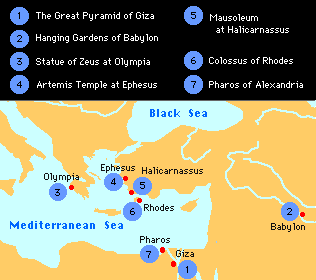The Seven Wonders of the WorldThe list of the Seven Wonders of the Ancient World was originally compiled around the second century BC, although Herodotus wrote about the idea as long ago as the 5th century BC. The final list of the Seven Wonders was compiled during the Middle Ages. The list comprised the seven most impressive monuments of the Ancient World, some of which barely survived to the Middle Ages. |

|
|
The Great Pyramids of Giza
The Great Pyramid of Khufu (Cheops) was built by the Egyptian pharaoh Khufu of the Fourth Dynasty around the year 2560 BC. The structure consists of approximately 2 million blocks of stone, each weighing more than two tons. When it was built, the Great pyramid was 481 ft high. It ranked as the tallest structure on Earth for more than 43 centuries. It is the oldest and only surviving 'wonder'. |

|
|
Hanging Gardens of Babylon
Terraced gardens adjoining Nebuchadnezzar's palace said to rise from 75-300 feet. Supposedly built by the king about 600 BC to please his wife, a princess from the mountains, but they are also asssociated with the Assyrian Queen Semiramis. Most descriptions of the Gardens come from Greek historians, but Babylonian records stay silent on the matter. |
|
Statue of Zeus at Olympia
|
Carved by Phidias, the 40-foot statue marked the site of the
original Olympic games in the 400s BC. It was constructed of ivory and gold, and showed Zeus on his throne. It was regarded as the greatest work in Greek sculpture. Today nothing remains at the site of the old temple except the foundation of the buildings, and fallen columns. |

|
|
Temple of Artemis
at Ephesus Constructed of parian marble and more than 400 feet long with over 100 columns 60 ft high, it was begun about 550 BC and took some 120 years to build. It was decorated with bronze statues sculpted by the most skilled artists of their time: Phidias, Polycleitus, Kresilas, and Phradmon. In 356 BC a man named Herostratus burned the temple to ground in an attempt to immortalize his name. |

|
|
Mausoleum at Halicarnassus
Erected by Queen Artemisia in memory of her husband King Mausolus of Caria (in Asia Minor), who died 353 BC. It stood 140 feet high. The beauty of the Mausoleum is not only in the structure itself, but in the decorations and statues that adorned the outside at different levels on the podium and the roof. All that remains are a few pieces in the British Museum and the word 'mausoleum' in the English language. |

|
|
Colossus of Rhodes
Gigantic bronze statue of the sun god Helios (or Apollo); it stood about 117 feet high, dominating the harbour entrance at Rhodes. The sculptor Chares supposedly laboured for 12 years before he completed it in 282 BC. It was destroyed by an earthquake about 226 BC. It has long been believed that the Colossus stood in front of the harbor straddling its entrance. That is improbable and recent studies suggest that it was erected on the eastern embankment of the harbor. |

|
|
Pharos of Alexandria
Marble lighthouse and watchtower built about 270 BC on the island of Pharos in Alexandria's harbour. Possibly standing 400 feet high, it had, at the top stage, a mirror which reflected sunlight during the day while fire was used during the night. Its reflection could be seen more than 35 miles off-shore. Of the six vanished Wonders, the Lighthouse of Alexandria was the last to disappear. It was destroyed by an earthquake in 1375. |

|
